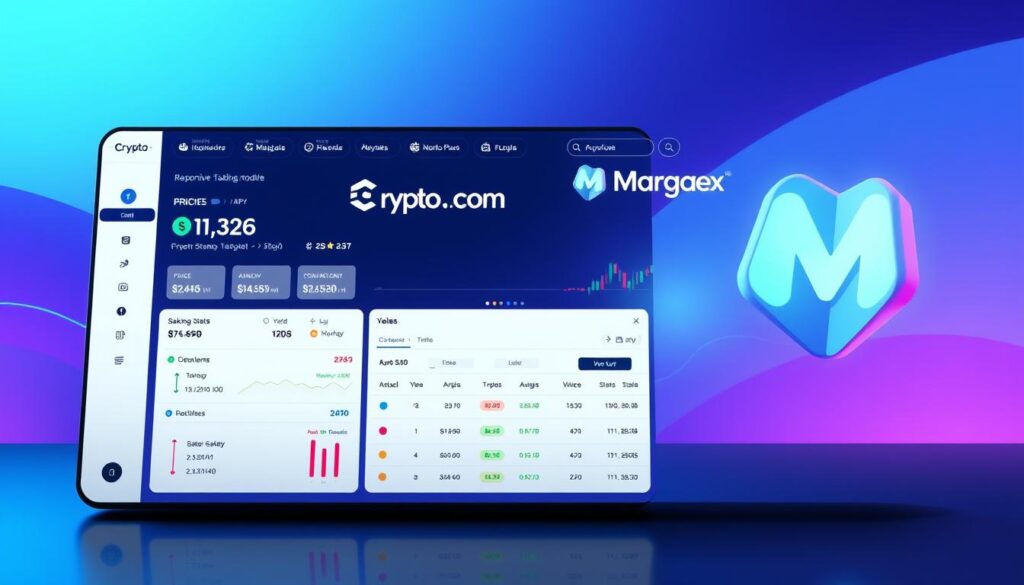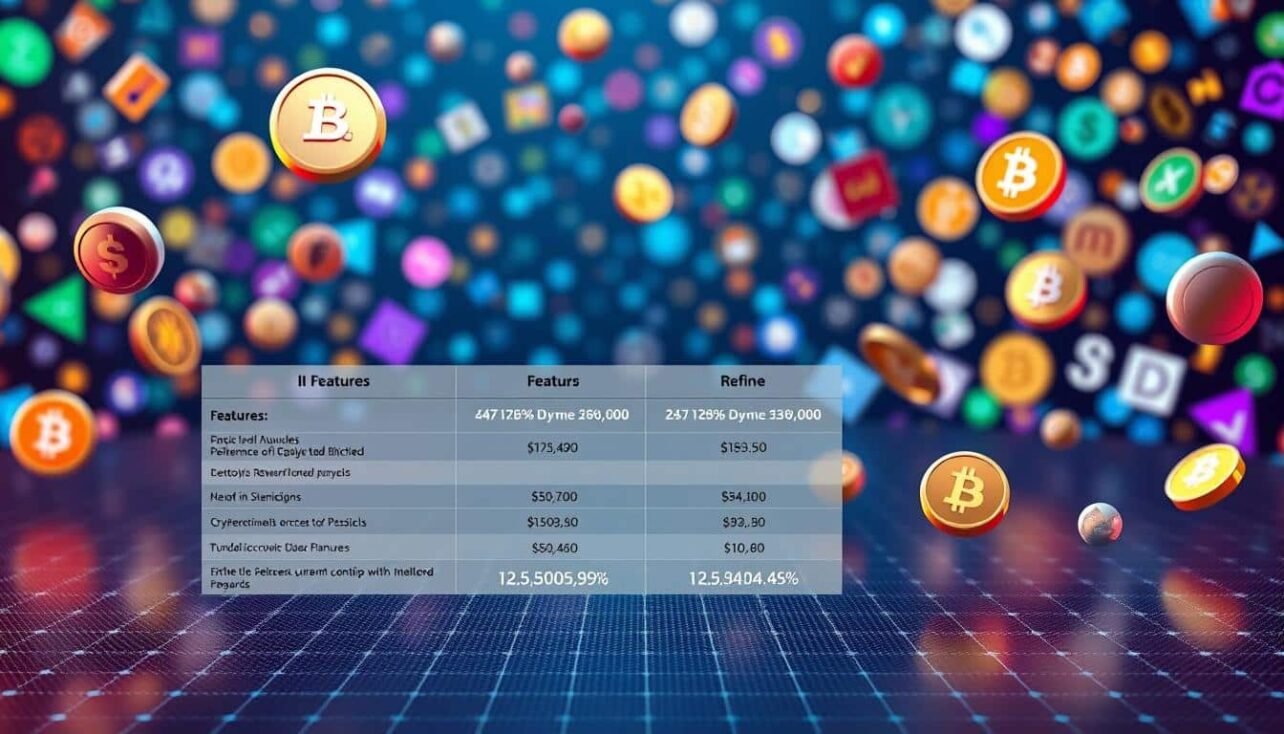Get the inside scoop on top options for earning with crypto. This guide helps U.S. readers weigh platforms like Binance, Coinbase, Kraken, Gemini, and others. We focus on clarity about actual earning potential, risk profiles, and which offerings suit different goals.
In this roundup, “rewards programs” includes staking yield services, Earn-style products, launchpools, and other ways users can stake crypto to generate ongoing income. Nominal APYs often differ from real returns after fees and inflation, so understanding net rates matters.
We’ll preview supported coins, on-chain vs. off-chain staking, lockups, fees, UX, mobile apps, and security controls. The guide compares centralized and decentralized paths and notes U.S. availability limits that may affect your choice.
This is informational, not investment advice. Reward opportunities come with volatility, liquidity limits, and possible slashing on some networks. Read on for a comparison table, quick at-a-glance picks, and practical next steps to match platforms to the assets you hold today.
Key Takeaways
- Learn which platforms offer the best fit for custody and ease of use.
- Understand the gap between nominal APY and real income after fees.
- See how lockups, fees, and security change risk for U.S. investors.
- Find whether on-chain or off-chain staking suits your goals.
- Use the guide to pick platforms that match compliance and asset needs.
What U.S. crypto investors mean by “rewards” today
For U.S. crypto investors, rewards usually describe yields earned on digital assets through staking, flexible Earn-style accounts, and launchpool credits that pay out daily or weekly.
Staking lets holders lock coins to help validate a blockchain network. Validators and delegators receive protocol emissions and sometimes fee shares. That creates steady yields that can compound if distributions are restaked.
These payouts differ from trading profits. Trading depends on price moves; rewards are ongoing yield but still face market risk, slashing, and lock-up periods. Custodial platforms automate participation for ease of use. On-chain staking with self-custody gives more control but more steps.
- Tax note: Staking income is generally taxed as ordinary income when received; later sales trigger capital gains or losses.
- Liquidity: Unbonding windows and lock-ups can limit access; flexible options often pay less.
- Risk: Protocol slashing, counterparty risk off-chain, and smart contract risk on-chain all matter.
Match the method to your comfort level: custodial simplicity for convenience or on-chain control for independence while you seek to earn passive income from your cryptocurrencies.
How we evaluate staking rewards programs and platforms
We convert headline yields into realistic, spendable income. Our methodology centers on the real reward rate, which adjusts nominal annual percentage yield for token inflation and platform fees. This gives U.S. investors a clearer sense of purchasing-power growth, not just headline APYs.
Methodology: real reward rate vs. nominal APY
Real reward rate = nominal APY minus token inflation and platform commissions. We use this to compare assets fairly. For example, current real rates include BNB 7.43%, ATOM 6.95%, DOT 6.11%, CRO 5.24%, ALGO 4.5%, ETH 4.11%, MATIC 2.58%, AVAX 2.47%, XTZ 1.58%, ADA 0.55%.
High nominal rates often hide token inflation. Focusing on real reward rate helps investors avoid misleading headline figures and choose assets that preserve value.
Ranking factors: security, supported coins, fees, UX
- Security measures: proof of reserves, cold storage, audits, insurance.
- Supported coins: breadth of assets and on‑chain staking options.
- Fees & terms: commission on staking rewards, lock-up length, and minimums (e.g., 32 ETH validator requirement).
- UX & mobile app: setup simplicity, dashboard clarity, clear unbonding times, and a stable mobile app for ongoing management.
- Operational factors: liquidity, market depth, uptime history, incident response, and regulatory availability for U.S. users.
- Customer care: education, community support, and responsive help channels.
| Evaluation Area | What We Measure | Why It Matters |
|---|---|---|
| Real reward rate | Nominal APY minus inflation & fees | Shows true purchasing-power growth |
| Security measures | Audits, cold storage, insurance, PoR | Reduces counterparty and protocol risk |
| UX & mobile app | Onboarding, dashboard, app stability | Improves retention and correct operation |
| Liquidity & history | Market depth, uptime, incident response | Impacts withdrawal access and resilience |
Bottom line: we balance yield versus platform and protocol risk to offer pragmatic, investor‑first ratings. That helps you choose staking platforms that align with goals and compliance needs in the U.S.
Cryptocurrency rewards program comparison
Below is a side‑by‑side look at how major venues present APYs, unbonding times, and fee cuts that alter net yield.
Side‑by‑side: APYs, lock‑ups, and fees
What to watch: flexible staking pays lower nominal rates but keeps liquidity. Locked terms boost APYs at the cost of lock‑up periods and unbonding windows.
| Platform | Model | Notes |
|---|---|---|
| Binance / Binance.US | Flexible & locked | 300+ supported globally; US availability reduced; up to ~25% commission on some U.S. offerings |
| Kraken | On‑chain focus | 16+ coins for staking; high transparency and on‑chain validator model |
| Coinbase | Custodial opt‑in | Simple staking UX; state restrictions and commission taken from payouts |
Custodial vs. non‑custodial: which fits you?
Custodial options (Binance Simple Earn, Coinbase opt‑in, Gemini Staking) simplify setup and automate compounding.
Non‑custodial on‑chain staking gives you control and transparency but needs more management and technical steps.
- Flexible staking — best for traders who need access.
- On‑chain staking — best for users who want self‑custody and validator choice.
- Fees — watch platform commissions, trading costs, and network fees that lower realized rates.
Top crypto staking platforms at a glance
Here’s a quick look at top staking platforms and the key trade-offs U.S. investors should weigh. Each entry notes core strengths, common limits, and whether U.S. access changes user experience.

Quick notes: Binance Simple Earn offers flexible and locked options across 300+ coins globally. Binance.US has fewer options and may take up to 25% commission on payouts.
Coinbase provides a simple opt-in flow and strong security posture, but commissions reduce stated APYs. Kraken focuses on on-chain staking, liquidity, and a high-security record; U.S. offerings shifted after regulatory changes.
| Platform | Headline Strength | U.S. Access / Caveat |
|---|---|---|
| Binance | 300+ coins; flexible & locked | Global breadth; Binance.US limited, commissions apply |
| Coinbase | Simple UX; high security measures | Regulated; commission on payouts |
| Kraken | On‑chain staking; liquidity | Strong security; evolving U.S. list |
| Bybit / KuCoin | Launchpools, fixed/flexible, many coins | High coin count; check U.S. availability |
| Crypto.com / Gemini / OKX | Mobile app focus; insured custody; ETH2.0 options | Gemini regulated; OKX min. notes; Crypto.com app benefits |
When shortlisting the best places to stake, check supported coins, fee splits, mobile app quality, and support channels before committing any digital assets.
For a deeper guide on selecting platforms, see our crypto rewards guide.
Binance, Binance.US, and OKX: breadth of supported coins and Simple Earn
Binance Simple Earn provides wide coverage, with 300+ supported coins globally and both flexible staking and locked terms. Flexible options keep funds liquid. Locked deposits often show higher stated annual percentage yield but require commitment.
Binance.US offers a smaller list for U.S. users and may take up to 25% commission on payouts. That commission can cut net rates sharply compared with the global exchange.
How OKX handles ETH2.0
OKX uses BETH for ETH2.0 staking with a low 0.1 ETH minimum. The platform provides proof of reserves and periodic airdrops for eligible BETH holders, which can add long‑term value.
- Regional differences: platform offers vary by jurisdiction; U.S. lists are often smaller.
- Stated vs. real rates: compare headline APYs to real reward rates after fees and inflation.
- UX notes: watch subscription caps, redemption timing, and alert tools that affect allocations.
| Exchange | Key feature | U.S. caveat |
|---|---|---|
| Binance | 300+ coins, flexible & locked | Not all offers in U.S. |
| Binance.US | Simpler list | Up to 25% commission |
| OKX | BETH ETH2.0, low min | Availability varies by region |
Security matters: proof of reserves and clear custody help reduce counterparty risk when you use a custodial staking service. Also, note that bitcoin staking is not native to the PoW blockchain; BTC “staking” products are typically derivative or savings structures.
For U.S. readers, verify current Binance.US and OKX features and consider diversifying across platforms to balance liquidity, yield, and counterparty exposure.
Coinbase, Kraken, and Gemini: regulated options for U.S. investors
Choosing a regulated venue can reduce counterparty uncertainty and simplify tax and compliance steps for U.S. investors who want to stake digital assets.

On‑chain support, fees, and security posture
Coinbase offers an opt‑in staking flow that is easy to use. The platform takes a commission from payouts, which lowers take‑home APY. Availability varies by state, so check your account before committing funds.
Kraken emphasizes on‑chain staking and transparency. It supports 16+ coins with weekly distributions and a validator‑forward model that gives users clearer protocol‑level exposure. Recent regulatory shifts changed some U.S. offerings, so supported staking coins may differ from its global list.
Gemini is a regulated exchange with a narrower set of supported assets (for example, ETH, SOL, MATIC by region). It highlights compliance, insurance, and audited custody as core security measures. Advanced staking options like a 32 ETH Staking Pro are limited by geography.
Geographic limits, supported coins, and yield expectations
Fee structures matter: commissions and service charges reduce end‑user APY. Read fee disclosures to understand net staking rewards rather than headline numbers.
| Platform | Model | Notes |
|---|---|---|
| Coinbase | Custodial opt‑in | Commission on payouts; state restrictions apply |
| Kraken | On‑chain staking | Weekly distributions; 16+ coins; U.S. list evolved |
| Gemini | Regulated custody | Smaller supported set; strong compliance and insurance |
Security‑first investors should favor clear disclosures on validator selection, slashing policies, and custody insurance. Also note that bitcoin staking is not native to Bitcoin; offers labeled as such usually use derivatives or yield products, not PoS validation.
Bottom line: match your custody preference and compliance needs to the platform you choose, and verify current supported staking lists and lock‑up terms before staking any assets.
Bybit and KuCoin: advanced features with high-yield opportunities
Bybit and KuCoin mix trading-grade tools with multiple earning paths so active users can chase yield while managing liquidity.
Bybit uses a dual approach: flexible savings for instant access and fixed-term options for higher returns. It runs launchpools and promotional drops that pay out daily or weekly. About 190+ coins are eligible for yields. Note: Bybit is not available to U.S. retail users.
KuCoin’s broad earning suite
KuCoin offers Simple Earn, fixed staking, lending, and KCS staking that can stack benefits. The exchange supports roughly 350+ coins and provides trading bots for active strategies. U.S. access varies and may need extra compliance steps.
| Platform | Supported assets | U.S. access |
|---|---|---|
| Bybit | ~190+ eligible | Restricted |
| KuCoin | ~350+ eligible | Varies |
| Common | Flexible & fixed options | Check eligibility |
Weigh the trade-off between liquid access and higher fixed-term rates. Verify proof-of-reserves, incident history, and communications to assess security measures. Remember that mentions of bitcoin staking usually mean savings or derivative yield products, not native protocol staking. Diversify across tenors and platforms and compare net returns after fees to estimate real take-home yield.
Crypto.com and Margex: flexible durations, tiered CRO benefits, and liquid staking
If you want both tradability and weekly payouts, Crypto.com and Margex offer distinct staking choices worth considering.

Lock‑up periods, weekly distributions, and platform offers
Crypto.com provides flexible and fixed terms (commonly 1–3 months). Distributions arrive weekly in the staked token, which helps users compound or reallocate cash flow for passive income.
The platform uses a tiered CRO model. Higher CRO stakes can boost yields and unlock card perks. Returns vary by asset, term length, and CRO level, so net yield depends on your mix.
Margex favors a liquid staking-style approach where assets remain tradable while earning yield. APYs run up to ~5% and features like MP Shield aim to reduce price-manipulation risk for active traders.
- Crypto.com supports staking across 30+ assets and emphasizes a mobile app experience with dashboards and renewal reminders.
- Margex supports fewer coins but appeals to traders who want tradability plus staking service features.
- Flexible tenors lower rates; fixed lock-up periods boost APY but reduce liquidity.
| Feature | Crypto.com | Margex |
|---|---|---|
| Term types | Flexible & fixed (1–3 months) | Liquid staking-style, tradable |
| Distributions | Weekly in staked asset | Frequent; tradable tokens |
| Max APY | Varies by asset & CRO tier | Up to ~5% |
| Mobile app | Yes — mobile-first dashboard | Yes — trader-focused tools |
Bottom line: combine flexible and fixed allocations to balance liquidity and higher yields. Always check net returns after fees and confirm U.S. access before staking digital assets.
Best crypto assets to stake now: real reward rates and inflation impact
Real reward rates matter more than headline APYs. They subtract token inflation and platform fees so you see true take‑home yield.
- BNB — 7.43%
- ATOM — 6.95%
- DOT — 6.11%
- CRO — 5.24%
- ALGO — 4.50%
- ETH — 4.11% (32 ETH to run a solo validator; pooled and exchange options exist)
- MATIC — 2.58%
- AVAX — 2.47% (≈25 AVAX minimum for validators)
- XTZ — 1.58%
- ADA — 0.55%
Solana shows a near‑7% nominal rate but a ~‑0.05% real rate today, so it is excluded from the “best crypto” shortlist for staking now.
Practical on‑chain paths: use Keplr for ATOM, Avalanche wallet for AVAX, MetaMask with Polygon staking portals for MATIC, and Algorand Governance for higher ALGO payouts.
Balance protocol maturity, governance rights, and diversification across networks to reduce single‑chain risk. Always verify current protocol rates and platform payouts before staking any crypto assets.
On‑chain vs. off‑chain staking, plus staking vs. lending
Deciding between self-custody staking and platform-managed options starts with weighing control versus convenience. On-chain staking means delegating or running a validator directly on a blockchain network. That gives transparency and private‑key control but exposes you to slashing and smart contract risk.

Off-chain staking uses a centralized venue to operate validators for you. It simplifies setup and aggregates liquidity, but it introduces counterparty and custody risk, including rehypothecation in some cases.
Liquidity differs sharply. Flexible staking on platforms may allow near-instant withdrawals at lower rates. On-chain unbonding and lock-ups delay access but can offer higher take-home yield.
Staking secures PoS networks and distributes protocol payouts. Lending instead loans crypto to borrowers for interest and carries credit and platform insolvency risks. Note: bitcoin is PoW, so claims of bitcoin staking usually refer to savings or structured yield, not validator rewards.
| Path | Custody | Main risk |
|---|---|---|
| On‑chain staking | User keys (self‑custody) | Slashing, smart contract bugs |
| Off‑chain staking | Platform custody | Counterparty, insolvency |
| Lending | Platform or loaned out | Borrower default, platform failure |
Practical tip: consider a hybrid approach—keep core holdings in self‑custody staking and use platform services for assets or durations when convenience matters. Always review validator selection, slashing coverage, and how flexible staking handles redemptions in stress events to better earn passive income and manage risk.
U.S. regulations, taxes, and risk management for staking rewards
Regulatory enforcement and state rules have meaningfully changed how platforms offer staking and similar services to U.S. users. That affects availability, account structures, and how payouts are presented.
SEC actions, platform availability, and reporting staking income
Enforcement has moved markets: in 2023 Kraken settled with the SEC for $30 million and narrowed its U.S. staking services. Many exchanges adjusted features or offered opt-in models to meet guidance.
Tax basics: report staking as ordinary income when received at fair market value. Track that value as your cost basis so later disposals trigger proper capital gains or losses.
Slashing, market volatility, and platform security measures
Key risks include protocol slashing, market swings that erode nominal payouts, platform security incidents, and lock-up windows that limit liquidity.
- Check platform security measures: proof of reserves, audits, cold storage, and insurance.
- Confirm regional availability and whether offerings are custodial, pooled, or modified to comply with U.S. rules.
- Keep detailed records, 1099s, and transaction histories for accurate tax reporting.
| Action | Why it matters |
|---|---|
| Diversify platforms & networks | Limits counterparty and protocol concentration |
| Review lock-up terms | Protects liquidity planning |
| Enable strong account controls | 2FA, allowlists, and withdrawal gates reduce compromise risk |
Practical note: published rates can change fast. Align staking choices with your compliance comfort and consult a tax pro for complex situations.
Your next steps to choose the best place to stake and earn rewards
Focus on security and transparency first. Shortlist U.S.-accessible platforms that support the crypto assets you hold and confirm state-level availability and commissions.
Compare real reward rates (not just headline APYs) for assets like ETH, ATOM, DOT, BNB, and ALGO. For a quick rate reference see best crypto staking.
Decide custody: self-custody for control or a reputable custodial platform for convenience. Map liquidity needs across flexible and locked tenors.
Diversify across 2–3 platforms and networks, build a simple tax and recordkeeping workflow, then start with a small test stake. Reassess quarterly and scale as confidence grows to earn steady passive income.


No comments yet